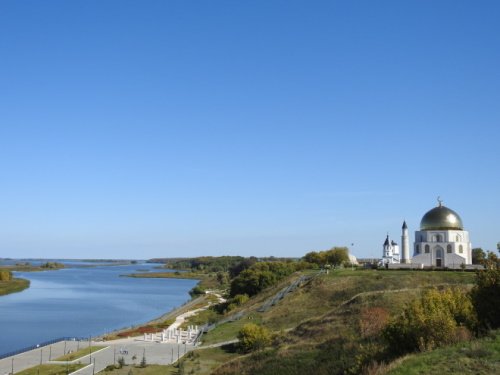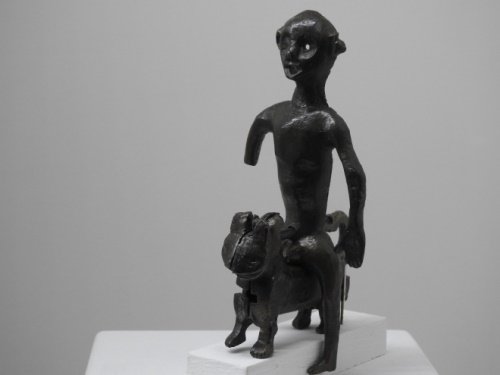Els Slots
WHS #721: Bolgar
A trip to Bolgar is just what ICOMOS did not want it to be: an introduction to the Volga Bolgar civilization. It was an uphill struggle to get this site inscribed as a WHS: only at the 4th try it succeeded and with a significantly limited OUV statement. However, for the Tatar Republic and especially the Islamic Volga Tatars this is so much more – nothing less than the heartland of their civilization. Volga Bulgaria (c. 700–1238), the earliest known organized state within the boundaries of Tatarstan, was an advanced mercantile state with trade contacts throughout Inner Eurasia, the Middle East, and the Baltic.

Getting there is a bit tricky because it is in a remote location not close to any sizeable town; see this Forum post for transport options. I visited Bolgar with a Russian group tour by bus, organized by Hotel Tatarstan. This only cost 1899 rubles (26 EUR), including lunch and entrance fees. The normal admission price is 400 rubles (EUR 5.50). It was a full day trip from 9 a.m. to 8 p.m, of which we spent 5 hours at the site itself. The site is very extensive, we were transported by bus between the various museums and monuments. There are bikes and golf carts for hire at the entrance if you make it here under your own steam.
The drive up to Bolgar is already worth it: good, quiet roads lead through a rolling green landscape. There were many sunflower fields along the road. We also crossed the impressive Kama River, a tributary of the Volga River that is more than 1,800 kilometers long (I first thought it was a lake – that’s how wide it is). At Bolgar itself, the wooden houses of the current inhabitants stand among the monuments. There will probably be many tourists here in the summer season, as can be seen from the number of souvenir stalls. Many of them were now (mid-September) closed. In addition to our bus, there was only one other bus with Russian tourists present.
We started our tour at the museum. It looks new and we had to put plastic covers over our shoes. The history and excavations from Bolgar and the surrounding area are exhibited here on 3 floors. Explanations are written in Russian, Tatar and English. The archaeological findings on site have been numerous, which should do away with any doubts about the importance of the site. They especially found a lot of handicrafts, made from clay, glass and bones. Most are utensils, there are no real top ornamental pieces.

Next to the museum there is something at the waterfront that looks like a large mosque. However, it is a museum dedicated to the Koran. The largest printed Koran in the world is stored in the central part. It was made by a group of Italians and Slovenes, and was donated to the Republic of Tatarstan in 2011. So nothing historic and very kitsch. The Volga Tatars (of nomadic origin) converted to Islam in 922 and this is commemorated here. The old nomads by the way had chosen a beautiful place to put up their tents permanently: Bolgar lies at the banks of the Volga, at a strategic point where you can look up the river for a long way. It all seemed peaceful now, only a single fisherman was rowing on the river.
After lunch in the “Bread Museum” (at the far end of the historic complex) we made a quick dash into the "White Mosque", a new addition to the Bolgar landscape (from 2012). The huge mosque in Moghul style is in religious use - we heard the call to prayer and saw the imam walking by with a number of guests – but I doubt many believers will make it out here.
The most historic part of Bolgar was left for last at the tour. This is a small cluster of monuments near the Volga, enclosed within the remains of a wall – the part you see in most photos of Bolgar. Under these mostly reconstructed buildings lie the remains of medieval Bolgar. We started with what is left of the 13th century mosque. Only the contours on the ground can be seen. Next to it is a beautiful minaret - a 21st century copy of the original that collapsed in 1841. Behind the mosque lies an 18th-century Russian Orthodox church. Tombstones with Arabic inscriptions from the historic Bolgar were used for the foundations of the church and are still visible.

The most interesting I found the former burial monuments of Bolgarian noble families, of which the interiors can be visited. One of them was used as a Christian church in later times. Now pigeons have nestled there.
Bolgar is still a wonderfully secluded site which gives insights in an ancient civilization that I didn’t know about. Yes, some parts of the complex are very kitsch and fake, but its history and beautiful location on the Volga river bank make up for that.
More on
Els SlotsComments
No comments yet.
